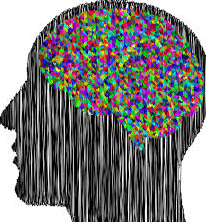Not all Wounds are Visible
September 9, 2021
Not all Wounds are Visible
The stigma of mental health, and how it can harm those who struggle
Stigma; what is it? Or, more specifically, where does it come from? Lack of knowledge, understanding, and fear of the unknown can often affect someone’s view on a subject, especially one that is controversial in nature. The negative connotations that are associated with mental health can often incite fear into someone who struggles with it. More than half of people who have mental illnesses don’t receive help with their disorders due to what they have heard from others. Stigma and stereotypes of any time can be and are harmful and, in some cases, can kill.
It is more common than not that people will avoid or delay the treatment of their mental illness because they are afraid to be treated differently. The fear of losing a job, livelihood, or reputation can often scare people into hiding and can result in them having to deal with their mental illness themselves. No one should have to face a battle against a mental disorder alone, as it not only can harm themself, but also their loved ones.
There are three broad types of stigma; discrimination, predjudice, and stereotyping. Some effects of stigma include, but are not limited to, the following; reduced hope, lower self esteem, increased psychiatric symptoms, difficulties with social relationships, reduced likelihood of staying with treatment, difficulties at work, school, etc., being reluctant to reach out for help or treatment, social isolation, lack of understanding from peers, few opportunities for work, school, and social events, bullying, physical violence, or harassment, the belief of being hopeless or helpless, the belief of never succeeding, or the believe that you can never improve in your situation.
All of these are the result of misconceptions surrounding mental health. Learning how to recognize the hurt that stigma against mental health and therapy brings, what it looks like, and how to address it can help eradicate and normalize the talk of mental health and mental health services.
For most people who perpetuate harmful stereotypes about mental health, they act this way because the stigma is efficient in a social setting. It can often help them generate quick first impressions or expectations when they meet someone who is open about being mentally ill. These people also tend to believe that psychologists or therapists only work with or meet “crazy” people. However, this expectation or belief is almost entirely wrong; most therapists meet with everyday people who are struggling in some aspect of their life, and need outside support from a professional.
Many people see a mental health expert for many different reasons. No matter what the reason may be, seeking help from a source who is trained to work and help those who are struggling is an invaluable investment into someone’s mental, physical, and emotional wellbeing.
It is also important to note that in most situations, you won’t find the perfect fit for your therapist or counselor on the first try. Sometimes, you won’t find the perfect fit on the second try, either. Finding the therapist or counselor who is right for you will improve your experience tenfold.
Reaching out can be a very scary and intimidating experience, and stigma is one of the most cited reasons on why. It is for this reason that mental health, and seeking mental health services, should be an accepted and open discussion for everyone to participate in.
Addressing stigma
What to do if you see it
Most people may think that mental illness is a hard thing to notice or address, but sometimes, mental illness can be right under your nose. If you have a friend, family member, or contact who has a mental illness or is seeking help for their issues, it can make these situations much more real and relatable. One of the most common reasons why people stigmatize is because of fear of the unknown.
Individuals who decide to speak out about their situations almost always have a positive impact on the pandemic that is stereotypes. If someone decides to share their story about their own mental health journey, it is important to listen to them, and do more research on the topic on your own, or politely ask them questions.
It’s also vital to accept, and respect, the conversation, and acknowledge that not all mental illnesses are visible. Additionally, speak out against people who are discriminatory to someone because of something they can’t help. Being a bystander in situations like those is almost as harmful as the people who are exhibiting harmful behavior.
If you prefer to address and normalize mental health in a more passive manner, there is always the option to donate or support organizations, charities, or non profits that are aiming to raise awareness or help people who struggle with mental health. Some amazing examples include Mental Health America, National Institute of Mental Health, National Alliance on Mental Illness, American Foundation for Suicide Prevention, Child Mind Institute, and National Council for Behavioral Health.
People who seek counsel with a therapist can also help reduce stereotypes and discrimination by being open and honest about their treatment, if they are comfortable. It’s also important to be compassionate to everyone. You never know what they may be going through.
A final suggestion on how to address or recognize stigma is to be conscious of your language and considerate of those it may offend. It is important to remember that everyone deals with offensive language differently. When one person may not be affected or phased by this, another may find it devastating, and that is the last thing that anyone should want.
The “DOs” and “DON’Ts” of mental health
What to and what to not say to someone who is struggling
| The “DOs” | The “DON’Ts” |
|
|




